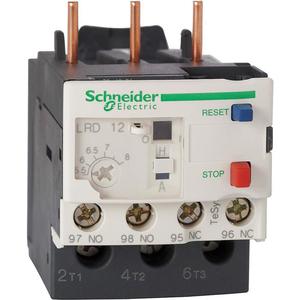Square D LRD14L overload relay is suitable for protecting motors from overheating due to excessive currents. It is connected to a motor starter or contactor to monitor current flow and detect overloads to quickly interrupts power, thus preventing damage.
Features:
- It has a thermal adjustment dial to control and ensure that electrical equipment operates efficiently without risking overheating or damage.
- This TeSys relay comes with a manual-automatic reset selector allowing users to choose between manual or automatic reset modes based on their operational preferences.
- It is equipped with a test selector for evaluating the relay's response to potential faults without compromising your system's integrity.
- This Square D LRD14L overload relay is equipped with reset and stop buttons that provide quick access to operational functions.
- It has a flag indicator facilitating visual feedback allowing instant assessment of the relay's status for increased safety.
- This relay is protected by a transparent cover that is lockable by sealing for preventing unauthorised or accidental alterations.
- Model LRD32L relay has higher amperage rating ranging from 23 to 32A.
Frequently Asked Questions:
Q. What type of contact orientation is available in Square D LRD14L overload relay?
A. It comes with two auxiliary contacts (one normally open and one normally closed), gaining a valuable fault signalling mechanism, significantly improving its capacity to communicate potential issues to your monitoring or control systems.
Q. How to choose an appropriate overload relay for my electrical system?
A.
- Understand current range, voltage and equipment type.
- Match motor ratings, including full-load and locked rotor currents.
- Ensure the relay's settings are adjustable to fit your system.
- Choose based on the duty cycle and operational environment.
- Verify compatibility with the control panel and other components.
- Account for environmental factors, certifications and safety features.
Q. How to maintain this Square D LRD14L overload relay?
A.
- Regularly inspect for visible damage, wear and loose connections.
- Keep the relay clean from dirt and debris using gentle methods.
- Test its functionality periodically by simulating load conditions.
- Calibrate adjustable settings as needed to match equipment requirements.
- Ensure proper terminal connection tightness, considering environmental factors and refer to the manual for specific maintenance guidelines.




